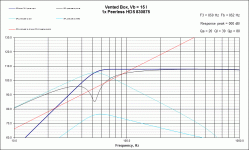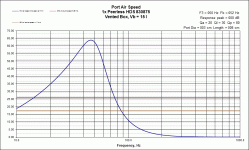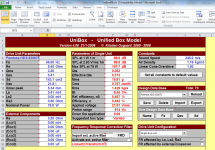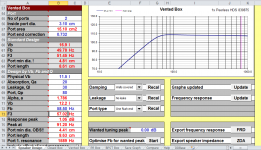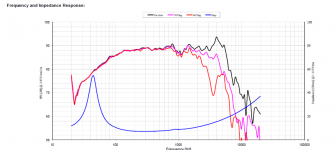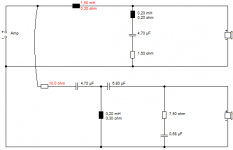Hi there. I'm hoping to get some assistance with some speakers I'm having a go at building. Although I've built and repaired plenty of amps and turntables in my time, speakers are a new thing to me and I'm struggling with the crossovers and port tuning. I'm limited inasmuch as the cabinets were ready made (AVI Duo, bought empty and new).
The Drive units I'm using are SS D2905/9300 and Peerless HDS P830875 (I've included the spec sheets below).
I'd like to aim for a crossover somewhere around 1.8khz to 2.5khz. Looking at the midwoofer spec sheet, I'm guessing the lower the better??
Cabinet dimensions I have are 400mm x 195mm x 280mm (HWD) and there are two 35mm diameter holes in the front face. Although they are small floorstander, the lower chamber is separate and sealed from the upper chamber.
I read AllenB's very informative postings re XO's and had a bash at knocking some up, but they don't really work. There seems to be no bottom end at all. I'm guessing this is due to baffle step? Also they seem VERY sensitive.
Like I said, I'm very new to this area, but have a good understanding of electronics and pick things up pretty quickly. However please be gentle x
Midwoofer
http://www.falconacoustics.co.uk/downloads/Peerless/830875.pdf
Tweeter
http://www.falconacoustics.co.uk/downloads/Scanspeak/d2905-930000.pdf
So basically just requesting help with the crossover and port length. I'm certain you clever people can assist me
The Drive units I'm using are SS D2905/9300 and Peerless HDS P830875 (I've included the spec sheets below).
I'd like to aim for a crossover somewhere around 1.8khz to 2.5khz. Looking at the midwoofer spec sheet, I'm guessing the lower the better??
Cabinet dimensions I have are 400mm x 195mm x 280mm (HWD) and there are two 35mm diameter holes in the front face. Although they are small floorstander, the lower chamber is separate and sealed from the upper chamber.
I read AllenB's very informative postings re XO's and had a bash at knocking some up, but they don't really work. There seems to be no bottom end at all. I'm guessing this is due to baffle step? Also they seem VERY sensitive.
Like I said, I'm very new to this area, but have a good understanding of electronics and pick things up pretty quickly. However please be gentle x
Midwoofer
http://www.falconacoustics.co.uk/downloads/Peerless/830875.pdf
Tweeter
http://www.falconacoustics.co.uk/downloads/Scanspeak/d2905-930000.pdf
So basically just requesting help with the crossover and port length. I'm certain you clever people can assist me
What length ports were you using? If you haven't done any modeling your lack of bass may not be crossover related. If you have excel I would recommend downloading unibox and doing some modeling of vented enclosures. if you don't have excel then winisd will do the trick.
I just did a sim based on the manufacturers specs and I would say that 20L (roughly the size of your enclosure minus a bit for the driver) is too much for this driver. Standard design in unibox says 16.9L but I personally would go for about 15L.
Your not going to get very extended bass out of this driver in a standard vented enclosure, but with a 15L volume and tuned to about 50Hz it should be ok down to around 50Hz.
I made an assumption that with 35mm diameter holes in your baffle that you would have 30mm ID ports. with 30mm ID ports the sim says 7.71cm long (each for two). Note that Troels Gravesen has done some research and found that the tuning usually ends up being lower than the sim would suggest. vent tuning
I would first get your box tuning right before you start to try tweaking the crossover. You can always add some bricks or other material to reduce the volume of the enclosure.
Note that with 3cm ports, at anything higher than moderate volume you will get port noise. See second graph.
Tony.
I just did a sim based on the manufacturers specs and I would say that 20L (roughly the size of your enclosure minus a bit for the driver) is too much for this driver. Standard design in unibox says 16.9L but I personally would go for about 15L.
Your not going to get very extended bass out of this driver in a standard vented enclosure, but with a 15L volume and tuned to about 50Hz it should be ok down to around 50Hz.
I made an assumption that with 35mm diameter holes in your baffle that you would have 30mm ID ports. with 30mm ID ports the sim says 7.71cm long (each for two). Note that Troels Gravesen has done some research and found that the tuning usually ends up being lower than the sim would suggest. vent tuning
I would first get your box tuning right before you start to try tweaking the crossover. You can always add some bricks or other material to reduce the volume of the enclosure.
Note that with 3cm ports, at anything higher than moderate volume you will get port noise. See second graph.
Tony.
Attachments
I've just had a remeasure (using a tape this time and deducting wall thickness) and the internals are 330mmx159mmx244mm. Port lengths are 31mm i/d x 70mm.
Ultimately I want to lower the sensitivity to around 86db. There's definitely no discernable bottom end below around 150hz, so pretty sure the ports aren't to blame, given your suggestion re: port length, so that would lead me towards baffle step (I haven't added any compensation for this).
Ultimately I want to lower the sensitivity to around 86db. There's definitely no discernable bottom end below around 150hz, so pretty sure the ports aren't to blame, given your suggestion re: port length, so that would lead me towards baffle step (I haven't added any compensation for this).
OK that changes things somewhat! That probably in reality equates to a volume of around 11.5L with the drivers volume subtracted. I suspect 7cm is probably a little bit short, for the ports. Increasing to 8 or 9cm may give you an improvement. I'd aim for box tuning around 55Hz. Unibox says 10cm but using troels guide 8 - 9 cm may be closer.
Actually adjusting using the 0.81 multiplier 7cm may be pretty ok with that volume.
If you want to start trying to work out baffle step you have two options Without resorting to measurements). Download something like "the edge" (or some of the other baffle step simulators) and make up a dedicated baffle step circuit. Or go here software and have a look at Dave dal Farra's excellent article on designing crossovers without meausrements which uses manufactures response curves and a range of simulation programs to allow you to design a crossover for your speakers. If you go this route you can design baffle step into the actual crossover rather than having dedicated baffle step circuitry.
Tony.
Actually adjusting using the 0.81 multiplier 7cm may be pretty ok with that volume.
If you want to start trying to work out baffle step you have two options Without resorting to measurements). Download something like "the edge" (or some of the other baffle step simulators) and make up a dedicated baffle step circuit. Or go here software and have a look at Dave dal Farra's excellent article on designing crossovers without meausrements which uses manufactures response curves and a range of simulation programs to allow you to design a crossover for your speakers. If you go this route you can design baffle step into the actual crossover rather than having dedicated baffle step circuitry.
Tony.
Here is what I put into unibox.
Attachment one I got the T/S params from the spec sheet you linked to. I always put in at least 0.2 ohms series resistance (this accounts for resistance in the speaker wiring).
Attachment 2 shows what I put in for modelling your 7cm ports (divided by 0.81 as per Troels article for undamped boxes). Note that my own experience has been that the tuning of the box has been pretty close to unibox's predicted tuning, but that was with a relatively big box (70L) certainly a small box I made (2.5L) the tuning was quite different to what I expected, so I suspect the smaller the box, the bigger the discrepancy.
The easiest thing to do is put in the size of your box, number of ports, port id and then just move the tuning frequency up and down and see what the effect is. Obiously if you don't have a fixed size box yet you can vary box volume as well.
The vented tab has useful graphs showing power handling, port air velocity, and step response, I really like the step response one, as it shows you how the transient response varies with different volumes and tuning frequencies.
Tony.
Attachment one I got the T/S params from the spec sheet you linked to. I always put in at least 0.2 ohms series resistance (this accounts for resistance in the speaker wiring).
Attachment 2 shows what I put in for modelling your 7cm ports (divided by 0.81 as per Troels article for undamped boxes). Note that my own experience has been that the tuning of the box has been pretty close to unibox's predicted tuning, but that was with a relatively big box (70L) certainly a small box I made (2.5L) the tuning was quite different to what I expected, so I suspect the smaller the box, the bigger the discrepancy.
The easiest thing to do is put in the size of your box, number of ports, port id and then just move the tuning frequency up and down and see what the effect is. Obiously if you don't have a fixed size box yet you can vary box volume as well.
The vented tab has useful graphs showing power handling, port air velocity, and step response, I really like the step response one, as it shows you how the transient response varies with different volumes and tuning frequencies.
Tony.
Attachments
Yes the sim does show that you should get pretty flat down to about 70Hz (without taking into account bafflestep). Did you put any padding on the tweeter? I'd say absolute minimum you need 2db of padding on it, and when you start dealing with baffle step on the mid, that will likely end up closer to 5 - 6db.
One other thing I would check is running just the woofer in the box full range (no crossover) and see how that sounds. If you have an error in your crossover it may be affecting the bass response.
You may want to have a look at crossover for mac (it's a program that lets you run windows binaries, not a crossover simulation program) It may allow you to run some of the software. Note that the link I gave to above has quite a few excel spreadsheets, in fact I think the only windows programs are the spltrace tools, I think everything else runs in excel. The spltrace is a single exe from memory so should run fine in a windows simulator.
edit: actually I had seen another (free) program for running windows software on a mac http://mac.appstorm.net/how-to/virtualization/run-windows-apps-on-your-mac-free-with-wine-bottler/ wine bottler... I've not got a mac so have no experience with either crossover or wine-bottler...
There are no doubt native tools for macos as well.
One other thing I would check is running just the woofer in the box full range (no crossover) and see how that sounds. If you have an error in your crossover it may be affecting the bass response.
You may want to have a look at crossover for mac (it's a program that lets you run windows binaries, not a crossover simulation program) It may allow you to run some of the software. Note that the link I gave to above has quite a few excel spreadsheets, in fact I think the only windows programs are the spltrace tools, I think everything else runs in excel. The spltrace is a single exe from memory so should run fine in a windows simulator.
edit: actually I had seen another (free) program for running windows software on a mac http://mac.appstorm.net/how-to/virtualization/run-windows-apps-on-your-mac-free-with-wine-bottler/ wine bottler... I've not got a mac so have no experience with either crossover or wine-bottler...
There are no doubt native tools for macos as well.
Last edited:
All this talk of crossovers and not a mention of what you are using! 
So you have bought an AVI Duo cabinet, and stocked it with the original drivers by the look of things:
AVI Hi-Fi Legacy - Duo review
AVI say 2.5kHz crossover on what looks like about 20L reflex. That's going to be about 2.2mH series and 8uF shunt bass circuit, if we forgo any sophisticated LCR notches around 4-5kHz. If the bass is the original model that AVI used, the tuning should be right anyway.
Then something like 6.8uF and 0.2mH tweeter if we tried second order, which I wouldn't, as it goes. But I'd have to model a third order here.
So you have bought an AVI Duo cabinet, and stocked it with the original drivers by the look of things:
AVI Hi-Fi Legacy - Duo review
AVI say 2.5kHz crossover on what looks like about 20L reflex. That's going to be about 2.2mH series and 8uF shunt bass circuit, if we forgo any sophisticated LCR notches around 4-5kHz. If the bass is the original model that AVI used, the tuning should be right anyway.
Then something like 6.8uF and 0.2mH tweeter if we tried second order, which I wouldn't, as it goes. But I'd have to model a third order here.
You mean you want SOMEONE ELSE to start from scratch! 
Downloads
This is not an easy speaker to do. I never get it sounding good. Other people claim they do, but always seem a bit short on detail. So I assume they are just making it up, as usual.
Bass tuning shouldn't be too critical. It's the filter that is hard. I have been playing with some series filters which look OK, but below is a typical 5kHz notch parallel circuit for this sort of thing. And the Peerless 830875 frequency response. Around 3kHz crossover. It could be a point of departure. The real difficulty is the erratic tonal response with 6" paper bass, and lack of natural rolloff and that 5kHz peak. It's quite a revealing speaker, but has an overly bright midrange on a simple crossover IMO. Something like a Vifa P17WJ polycone is just much easier.
I prefer the look of Michael Chua's Starling design for the similar SEAS ER18RNX. Nice circuit IMO.
"STARLING" (Seas 27TDFC + Seas ER18RNX) Bookshelf by AmpsLab
Downloads
This is not an easy speaker to do. I never get it sounding good. Other people claim they do, but always seem a bit short on detail. So I assume they are just making it up, as usual.
Bass tuning shouldn't be too critical. It's the filter that is hard. I have been playing with some series filters which look OK, but below is a typical 5kHz notch parallel circuit for this sort of thing. And the Peerless 830875 frequency response. Around 3kHz crossover. It could be a point of departure. The real difficulty is the erratic tonal response with 6" paper bass, and lack of natural rolloff and that 5kHz peak. It's quite a revealing speaker, but has an overly bright midrange on a simple crossover IMO. Something like a Vifa P17WJ polycone is just much easier.
I prefer the look of Michael Chua's Starling design for the similar SEAS ER18RNX. Nice circuit IMO.
"STARLING" (Seas 27TDFC + Seas ER18RNX) Bookshelf by AmpsLab
Attachments
Steve, I was trying to encourage Tristan down the path of starting to do sims. He took the initiative and read Allen's excelent tutorial, but came up short, and wasn't sure where to go next.
Taking a methodical approach making sure basics were ok to start with.
We'll see where he goes in time
Tony.
Taking a methodical approach making sure basics were ok to start with.
We'll see where he goes in time
Tony.
No criticism implied at all, Tony. 
Driver selection is the key to a good sounding speaker. I think this unpromising choice might be rescued from oblivion. Maybe with a complete rethink.
It's actually about as bad as it gets IMO. Soft dome tweeter and 6" bass? But hey, maybe there is hope.
Meanwhile, Diana Krall has just released a 2015 album "Wallflower" that is fairly spotless in choice of wonderful songs. Haven't quite tracked down "Alone again, naturally" yet.
https://www.youtube.com/watch?v=fk6JtDhA7WI
Driver selection is the key to a good sounding speaker. I think this unpromising choice might be rescued from oblivion. Maybe with a complete rethink.
It's actually about as bad as it gets IMO. Soft dome tweeter and 6" bass? But hey, maybe there is hope.
Meanwhile, Diana Krall has just released a 2015 album "Wallflower" that is fairly spotless in choice of wonderful songs. Haven't quite tracked down "Alone again, naturally" yet.
https://www.youtube.com/watch?v=fk6JtDhA7WI
If 6 inch drivers and soft dome tweeters are such a bad choice, why do so many existing manufacturers use exactly that combination? (not being combatative, just generally confused, is it a cost thing?). I was limited in my choices for drivers as the cabinets were already manufactured and only cost me £25. I'm not after anything "groundbreaking" or ultra high end, just something that sounds "good" and fits around what I already have.
I've been doing some fiddling and have discovered that the issue is definitely down to baffle step (if I stand to the side of the cabinet the bottom increases) and the lack of any compensation in my original design. I've also put l-pad in the highpass section as this was way too hot. It's getting there now. May try a notch filter also.Thanks for the help.
I've been doing some fiddling and have discovered that the issue is definitely down to baffle step (if I stand to the side of the cabinet the bottom increases) and the lack of any compensation in my original design. I've also put l-pad in the highpass section as this was way too hot. It's getting there now. May try a notch filter also.Thanks for the help.
Hi Tristan, I traced the spl curves last night. and normalised them. I think that is the main step that you need the pc software for. I think the rest can be done in the excell spreadhseets (which should work??)
Attached are frd and zma files for each speaker. The midbass one I used the FRD responseblender spreadsheet to blend the simulated response from unibox with the normalized measurement from the spl trace, and with cabinet dimentions for your cabinet (from here AVI Hi-Fi Legacy - Duo Loudspeaker) for the BS.
There are a lot of variations in the zip file. I did this so you can look at the changes along the way if you should so desire. The ones to actually use in PCD are:
Peerless_80875_blended_BS.frd
Peerless 80875.zma
ss93000_min_phase.frd
ss93000.zma
The ones with just the driver and .frd are the raw ones taken with the spltrace program (note I used a different one from the tutorials, and that multicoloured one from the midbass was a real PITA!)
The _normalised ones are normalised using splview
there are more for the midbass because there is a blended one without bs and one with bs.
I've tested loading these into pcd and they load fine.
Hopefully PCD (Passive Crossover Designer excell spreadsheet) should work properly on your Mac.
Tony.
Attached are frd and zma files for each speaker. The midbass one I used the FRD responseblender spreadsheet to blend the simulated response from unibox with the normalized measurement from the spl trace, and with cabinet dimentions for your cabinet (from here AVI Hi-Fi Legacy - Duo Loudspeaker) for the BS.
There are a lot of variations in the zip file. I did this so you can look at the changes along the way if you should so desire. The ones to actually use in PCD are:
Peerless_80875_blended_BS.frd
Peerless 80875.zma
ss93000_min_phase.frd
ss93000.zma
The ones with just the driver and .frd are the raw ones taken with the spltrace program (note I used a different one from the tutorials, and that multicoloured one from the midbass was a real PITA!)
The _normalised ones are normalised using splview
there are more for the midbass because there is a blended one without bs and one with bs.
I've tested loading these into pcd and they load fine.
Hopefully PCD (Passive Crossover Designer excell spreadsheet) should work properly on your Mac.
Tony.
Attachments
- Status
- This old topic is closed. If you want to reopen this topic, contact a moderator using the "Report Post" button.
- Home
- Loudspeakers
- Multi-Way
- Help designing a crossover for AVI Duo (sort of)
